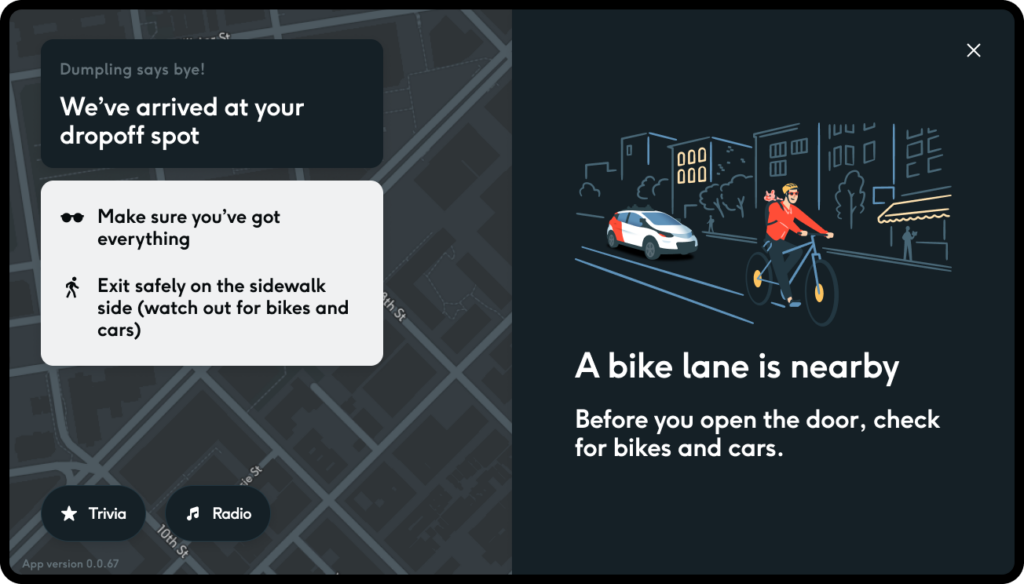DISCOVER YOUR LOCAL BICYCLING COMMUNITY
Find local advocacy groups, bike shops, instructors, clubs, classes and more!
Cruise endorses guidelines for safe interactions with cyclists – and shows how they’ll meet them
In the nascent autonomous vehicle (AV) industry, ensuring those vehicles interact safely with bicyclists must be a core competency. It’s why the League worked to develop guidelines for safe AV-cyclist interactions. We’re excited to see our vision for safer roads and safer riding endorsed by another other leader in the AV industry – Cruise.
Cruise is a Platinum sponsor of the 2023 National Bike Summit, March 26-29, 2023, in Washington, D.C. It is also one of only two companies offering paid rides in fully driverless vehicles to the public here in the United States. Last year, Waymo, the other company that offers paid rides in AVs to the public, endorsed the League’s guidelines for safe AV-cyclist interactions. Critically, the vast majority of the miles Cruise’s AVs have done for research, development, and deployment have been in San Francisco, a dense urban environment with lots of cyclists and a large and active cycling culture.
“The League of American Bicyclists is proud to say that with Cruise endorsing our guidelines for AV-cyclist interactions, every company currently offering paid rides in autonomous vehicles to the public acknowledges and recognizes the value of our principles,” said Bill Nesper, executive director of the League of American Bicyclists. “We hope at this industry continues to grow, so too does this commitment to the safety of all road users.”
When we discussed our principles with Cruise, it was great to hear how much Cruise and the League of American Bicyclists share a vision for a safer, more sustainable future for communities across the United States, where bicyclists of any age or experience level can get around town safely. Beyond endorsing the concept of safe AV-cyclist interaction and the utility of the six guidelines that the League developed, Cruise has already taken action to support a safer, more sustainable future. In 2021, Cruise advocated for AB 43 in California which reformed speed limit setting in the state, enabling local communities to reduce speed limits on high-injury networks.
Cruise was also excited to share not just their endorsement of our guidelines, but how they operationalize them. Today we’re excited to share their efforts with you. A recent survey by AAA showed that an increasing number of drivers are “afraid” of AVs, and sharing safety practices is an important part of building trust in these systems as they are developed. If you’re attending the Summit in person, Cruise will be there and we’re excited for attendees to share their experiences, concerns, and hopes with Cruise representatives at the Summit!
In 2021, the League developed six guidelines for safe AV-cyclist interactions – and here’s how Cruise meets them:
- Cyclists Should Be a Distinct Object Class
- Cruise distinguishes between bicyclists and pedestrians in order to be better able to anticipate and safely react to the unique movements and actions of people biking.
- Typical Cyclist Behavior Should Be Expected
- Cruise programs their vehicles to plan for, and react to, typical cyclist actions and less common or unexpected actions that are unique to people biking. Since the Cruise vehicle will never be distracted or intoxicated, and uses sensors that do not rely on ambient light to be effective, the vehicle is always ready to react, any time of day or night.
- Cycling Infrastructure and Local Laws Should Be Mapped
- Cruise regularly updates its system with road infrastructure data, including specific bicycle infrastructure such as bike lanes and bike boxes. By advocating for slower speed limits and safer infrastructure, Cruise recognizes the role of safer street design complementing their advanced technology. The presence of bike lanes is highlighted for users exiting the vehicle to alert them to the potential presence of a person biking.

- An AV Should Drive in a Consistent And Understandable Way
- Cruise designs for a safe, smooth, comfortable ride for users, with consistent use of mechanisms like turn signals to show its intention. In their development, this has led to subtle behaviors like the AV shifting slightly in the lane as a fast moving cyclist approaches for a potential overtaking maneuver.
- Prepare for Uncertain Situations and Proactively Slow Down
- Cruise prepares for uncertain situations by using redundant sensors – including LiDAR, radar, cameras, and microphones – to sense the world around the AV and potential conflicts. When potential conflicts are sensed or perceived, cautionary measures including reduced speed manage the potential risk as shown in this impressive interaction with a cyclist emerging after being obscured by a bus.
- Cyclist Scenarios Should Be Tested Continuously
- Cruise uses a mix of simulation and on-road testing, using real world scenarios and pre-designed events to test and re-test for interactions that are common and uncommon.
The League is excited to see how Cruise has approached our guidelines to safe AV-cyclist interaction. We believe that the safety of people biking should not be an “edge case” but must be a core competency of AV systems. We want all AV systems to be safe for people biking and to follow our guidelines or help us improve them. Engaging with safety technologies and making sure that cyclist safety is a part of their advancement is how we hope to create Safe Streets for All.